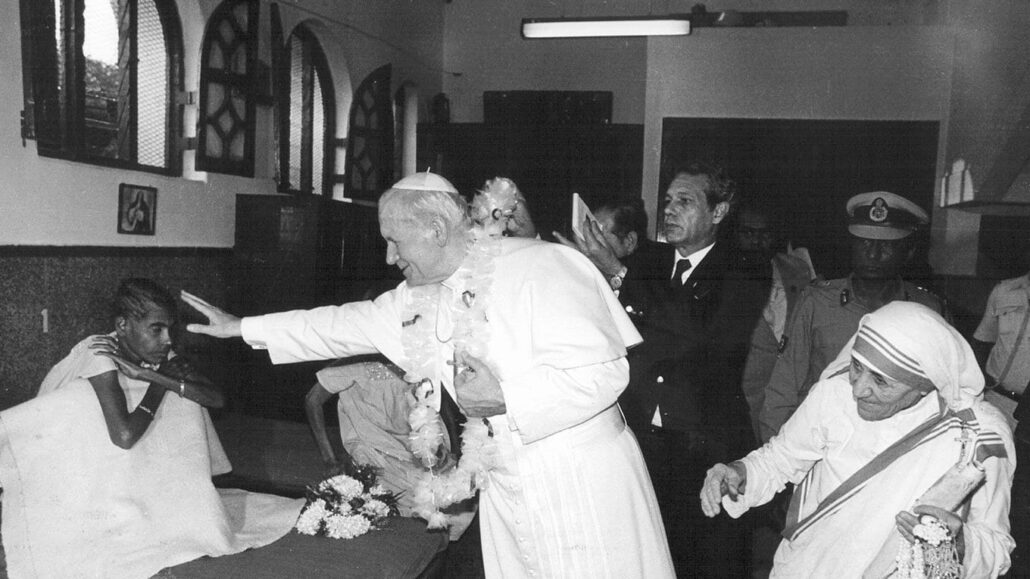In his autobiographical The Seven Storey Mountain, Thomas Merton remembers a conversation with poet Robert Lax. The two friends were strolling in Greenwich Village shortly after Merton’s conversion to Christianity when Lax suddenly asked: “What do you want to be, anyway?”
Taken by surprise, Merton rather lamely answered, “I don’t know; I guess what I want is to be a good Catholic.” Without hesitating, Lax shot back, “What you should say is that you want to be a saint!” Bewildered, Merton asked, “How do you expect me to become a saint?” “By wanting to,” replied Lax.
Merton’s friend was right. Our deepest, most heartfelt desire, even if we are not quite aware of it, is to grow ever more saintly or holy, to enter ever more intimately into relationship with God. All our other desires are either expressions or perversions of this wellspring.
A Saintly Life
Mother Teresa, called by many the “saint of the gutters,” or “saint of the slums,” because of her ministry to the poor, recognized her desire for holiness at a young age. Even though she put it aside for three or four of her teenage years, she rediscovered it by the time she was eighteen. The desire never deserted her, although, as we now know, she often felt that God had. For the rest of her days, her one goal was to live a holy life, a life pleasing to God and of service to suffering humanity, even when God seemed absent.
And she succeeded. So obvious was Mother Teresa’s sanctity that immediately after her death on September 5, 1997, her admirers began advocating for her canonization. Pope John Paul II was initially reluctant to speed up the process, but his admiration for Mother Teresa was so great that he eventually agreed.
The official investigation of her life, a necessary step toward canonization, began less than two years after her death, leading to her beatification in October 2003. In his homily on that occasion, Pope John Paul II said, “I am personally grateful to this courageous woman, whom I have always felt beside me.” She was, he noted, “an icon of the Good Samaritan.” Thirteen years later, on September 4, 2016, Pope Francis concluded the process when he declared Mother Teresa a saint, naming her forever as St. Teresa of Calcutta.
Images of Holiness
Most of us, of course, will always think of her simply and affectionately as Mother Teresa, the diminutive nun whose life and ministry to the poor was captured in thousands of iconic photographs. She’s always dressed the same, in the white sari with blue trim that is the habit of the Missionaries of Charity, the order Teresa founded and led for nearly a half-century. Another blue-bordered scarf covers her head and brow, and on her left shoulder, next to her heart, a small crucifix is pinned.
Teresa’s face is incredibly lined; even as a middle-aged nun she began to look older than her years. Her fingers are thick, blunted from years of scrubbing floors and toilets, and her hands’ wrinkled skin looks like elephant hide.

Her feet are small, with toes almost grotesquely misshapen from decades of wearing ill-fitting and secondhand sandals. She’s a small woman, just barely 4 feet, 11 inches tall. Age and labor have bent her back, making her even shorter. Toward the end of her life, she sometimes looked bent double.
In the familiar photographs, Teresa’s expression is alternately somber, reflective, contemplative, exhausted, and at times even angry. But occasionally the camera catches her when she’s smiling or joyfully laughing. She has a wonderful smile. It lights up her face and warms the heart of whoever sees it, even if only through the one-dimensional flatness of a photo.
The Girl Who became a Saint
In contrast to the thousands of photographic images of her as Mother Teresa of the Missionaries of Charity, there are only a few sepia-colored ones taken of Anjezë Gonxhe Bojaxhiu, the girl who grew up to become the saint of the gutters. In one of them, she poses with friends while holding an open umbrella. In another, taken shortly before she left home for India, she stares rather pensively at the camera. Perhaps she’s trying to catch a glimpse of her future.
These youthful photos, taken in the 1920s, are extraordinary. They reveal that Anjezë has thick, dark hair and a high, graceful forehead, both of which disappear forever behind a veil when she becomes a nun. Despite her short stature, she stands tall and straight. But there’s one unmistakable feature that remains constant in the early and later photos: her eyes. There’s something penetratingly luminous about them, as if they’re more than capable of reflecting both sheer joy and intolerable suffering. They are eyes, one’s almost tempted to say, which have seen God and are alert for another glimpse of the Divine. But they’re also eyes that have witnessed some of the worst suffering—disease, poverty, starvation, scorn, and indifference—that can afflict human beings.
If our eyes are indeed the windows of the soul, as some believe, the soul of the girl Anjezë and the woman Mother Teresa is holy indeed. And it’s that holiness, that living commitment to conform her human will to God’s, the same goal that Robert Lax recommended to Thomas Merton, which captivated the world during her lifetime and continues to hold us spellbound today. In examining Teresa’s life, her works, and her spirituality, we learn how to grow into our birthright as creatures made in the likeness of God. She teaches us how to open our eyes to see with her clarity.







